Learn how to make a whitening chocolate toothpaste with just six ingredients. Your teeth will have never felt cleaner!
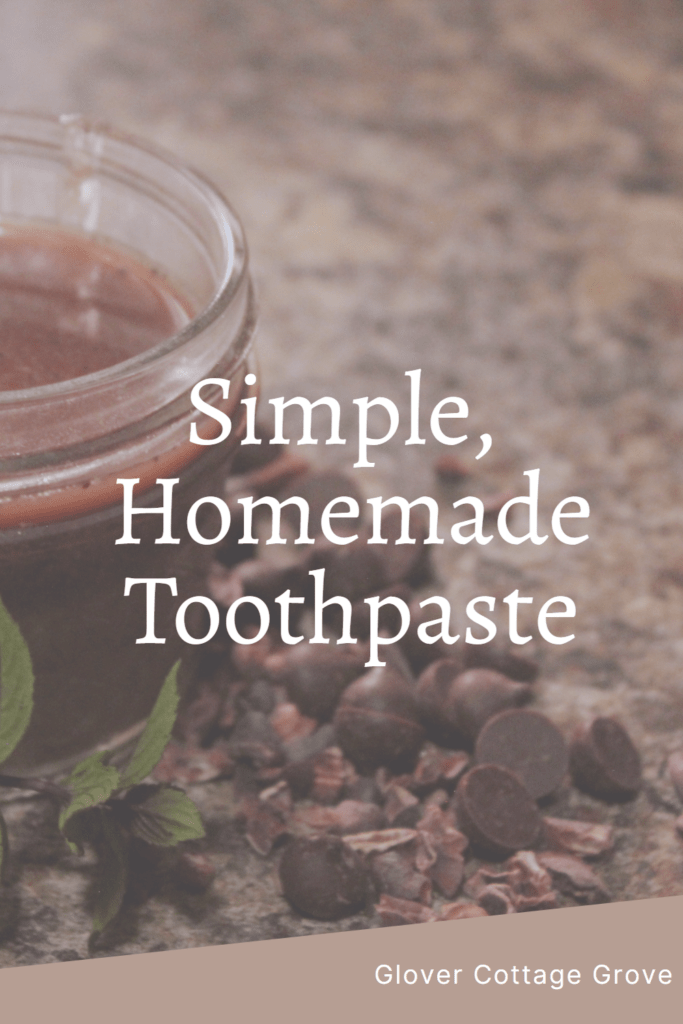
Why on earth would I brush my teeth with chocolate?
Chocolate toothpaste may sound like a strange choice for your dental hygiene. However, I’m not talking about using a chocolate candy bar—I’m talking about raw cocoa nibs mixed in with other highly beneficial ingredients for your mouth. Raw cocoa pieces are not only delicious to snack on but are also superstars when it comes to oral hygiene. Studies have shown that raw cocoa is more effective than fluoride at fighting against tooth decay and cavities. After learning this tidbit of information, I decided I should try to make my own toothpaste using this superfood. So I spent hours researching natural ingredients that are beneficial for your teeth and gums and tried to make the best toothpaste I could.
After using this chocolate toothpaste once, I was hooked. My teeth ACTUALLY felt clean rather than feeling filmy like they did after using traditional toothpaste. I’ve been using this as my only toothpaste for about 6 months now. My teeth are noticeably whiter and my entire mouth feels healthier and less sensitive! I have enjoyed my homemade toothpaste so much that I want to share the secret to my pearly whites with you.
The importance of good oral hygiene
The human mouth is a fascinating piece of the body. In fact, there are a “mouthful” of facts to keep in mind when brushing your teeth. Everything in the mouth serves multiple functions that affect everyone’s daily lives. The throat is where food goes and is a part of the airway. The tongue’s tastebuds make sure the food you’re eating hasn’t spoiled and that you even enjoy the process of eating. On top of this, the tongue’s flexibility is vital to correctly pronouncing most spoken languages. And the teeth act as the first step in digesting food and as an aid to the tongue in pronunciation when speaking.
Without any one of these processes, you wouldn’t survive. That’s why it’s so vital that you take care of your mouth like your life depends on it, because realistically, it does. Though, I’m sure you already know this. Every dentist in the world will say you need to brush your teeth multiple times a day and floss at least once a day. The American Dental Association says, “The consensus recommendation is for people to brush their teeth for two minutes twice a day with a toothbrush that has soft bristles.”
We agree with the experts completely on this. However, like with many things, our issue is not so much the activity, but finding healthy store-bought products. We have struggled to find store-bought toothpaste that doesn’t cause one issue or another. For us—and for my husband especially—we have sensitive teeth, and many toothpastes have made our teeth sore after brushing. Most toothpaste brands also add multiple chemical ingredients that improve the taste and shelf-life of their toothpaste but ultimately cause more harm than good, especially if ingested. The importance of brushing your teeth led us to one of our first steps into homesteading; finding the perfect, nontoxic and all-natural toothpaste.
What are the risks of store-bought toothpaste?
For some of the ingredients, toxicity is definitely a worry, but that’s not the only concern we had about store-bought toothpaste. They can also cause excessive wear on your teeth. For example, fluoride, one of the main ingredients used in toothpaste, does clean your teeth fairly well but is toxic if ingested in large enough amounts. Overexposure to fluoride can also cause a condition known as fluorosis. The symptoms of fluorosis are yellowed spots and white streaks on the teeth. According to NYU, fluorosis also causes the teeth to have poor mineralization, which runs directly opposite to how fluoride is supposed to aid in the remineralization of your tooth enamel.
The list of risks associated with the added chemicals are why we started looking for alternatives to store-bought toothpaste just after we started our homesteading journey. Through some trial and error, we found the recipe that we are sharing with you today and that we still use in our household. The things we looked for in our toothpaste were antibacterial properties to keep our mouths fresh, exfoliating properties to scrub the grime off our teeth without also wearing down our tooth enamel, the ability to help re-mineralize the enamel, and the ability to curate a healthy bacterial colony.
The best ingredients for oral health in our chocolate toothpaste
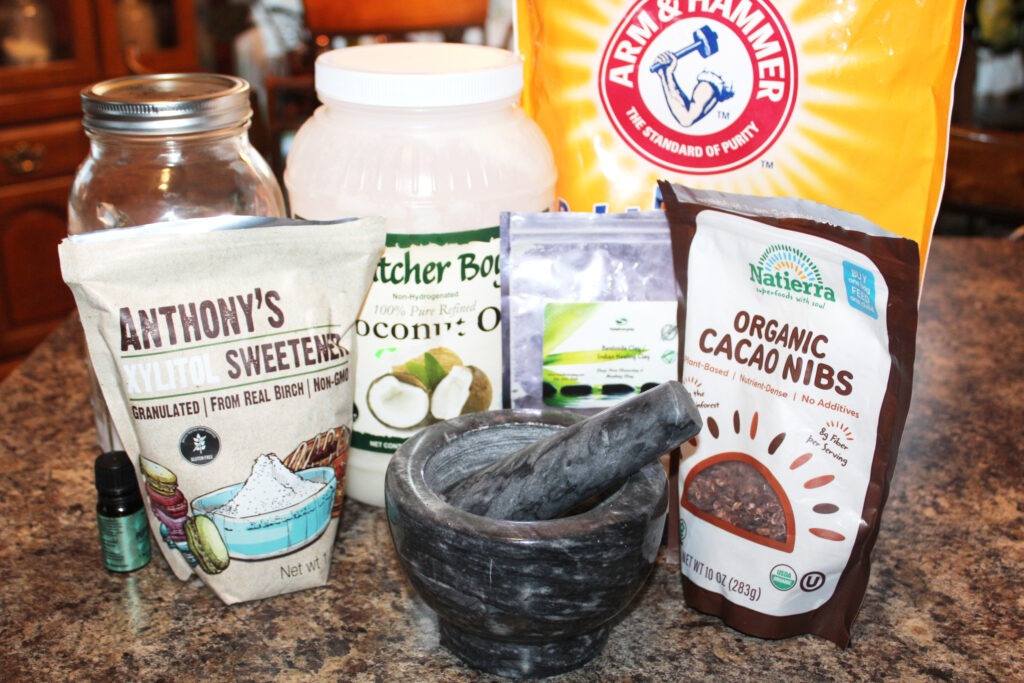
Cocoa Nibs
Cocoa nibs are what really makes this recipe shine. Did you know that chocolate is better at fighting tooth decay than fluoride, with virtually none of the side effects? Not only that, but chocolate can help strengthen your enamel and fight against cavities and plaque. You can find out more on the benefits of chocolate here. To get the most out of these benefits, we decided to use crushed organic cocoa nibs in this toothpaste.
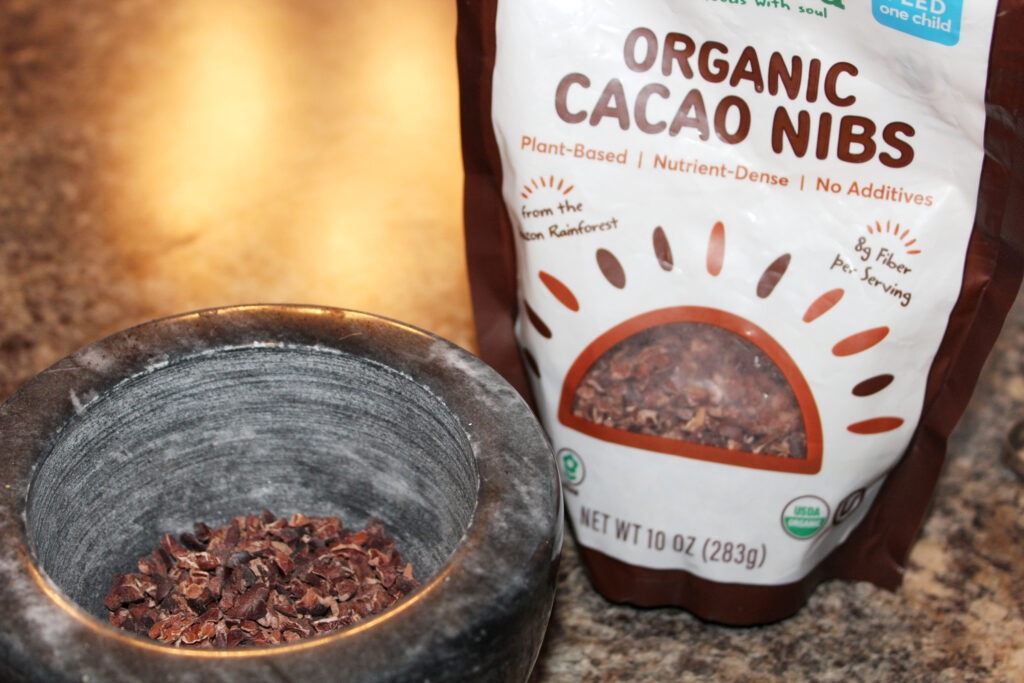
Coconut Oil
There’s a reason why many people recommend coconut oil for processes like oil pulling(a practice where you swish coconut oil in your mouth like mouthwash). It helps balance out the bacteria in your mouth by removing the bacteria associated with bad breath, tooth decay, and gum disease. This makes it a perfect base for this chocolate toothpaste recipe.
Baking Soda
Baking soda is also a wonderful addition to your oral hygiene. According to WebMD, it combats bad breath, tooth decay, and keeps your overall gums and mouth healthy. It also has whitening properties to help make your smile shine.
Salt
Salt has a surprising number of benefits for your oral health. According to MyDentalPlan, salt’s biggest benefit is that it helps balance your mouth’s PH levels to reduce the chances of tooth decay. Salt also contains the minerals necessary to keep your gums and tooth enamel healthy. Finally, salt helps reduce inflammation, which can minimize the effects of swollen gums or aching teeth. We personally recommend organic sea salt for this toothpaste.
Xylitol
Xylitol is used in gum for its ability to reduce the bacteria in your saliva that can cause tooth decay. On top of this, xylitol helps with dry mouth and reduces the risk of developing cavities.
Bentonite Clay
Like salt, bentonite clay is great at neutralizing the PH in your mouth and reducing the acidity. It also helps remineralize your teeth and strengthen your enamel, all while polishing your teeth to reduce plaque buildup. Bentonite Clay also helps reestablish a healthy bacterial colony in your mouth to prevent bad breath and decay.
Why are antibacterial properties important in your toothpaste?
Antibacterial properties are touted by medical professionals and non-professionals alike. Many companies advertise that their antibacterial products destroy almost 100% of all bacteria wherever applied. What many leave out, however, is that bacteria is a natural part of the human body. Many kinds of bacteria actually help the human body, such as the various bacteria that help the human body digest food and destroy waste. According to the NIH article, Oral Microbiom: Unveiling the Fundamentals, Priya Nimesh Deo and Revati Deshmukh conclude that,
Oral microbiome is crucial to health as it can cause both oral and systemic diseases. It rests within biofilms throughout the oral cavity and forms an ecosystem that maintains health in a state of equilibrium. However, certain imbalances in this state of equilibrium allow pathogens to manifest and cause disease.
The ingredients we use for this chocolate toothpaste recipe all work to maintain a fine balance in your mouth by scrubbing the grime off your teeth while not scratching away your gums and tooth enamel and disinfecting your mouth of the bad bacteria while maintaining the bacterial colony that keeps you healthy. These properties also make sure your breath smells great without forcing you to potentially eat toxic materials or unnecessary sweeteners found in drug store toothpaste.
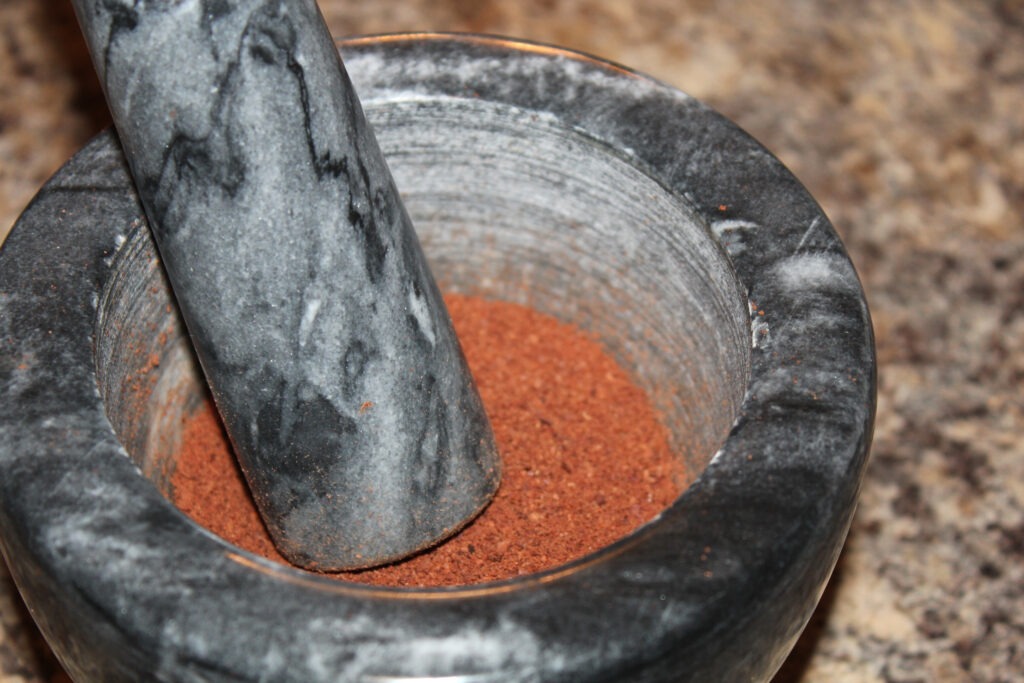
What are the risks of using a homemade toothpaste?
Everyone has their own unique mouth bacteria, so what works for my husband and I might not necessarily work for you. Always be sure to consult your dentist before starting to use any homemade toothpaste to address potential issues. If you develop any adverse side effects or have an allergic reaction to this toothpaste, stop using it immediately. Another thing to note is that homemade toothpastes don’t have the preservatives used in store-bought toothpaste. If your toothpaste looks or smells off, discard it and make a new batch. All of this being said, we hope that this recipe works for you like it has for us!
Instructions for all-natural chocolate toothpaste
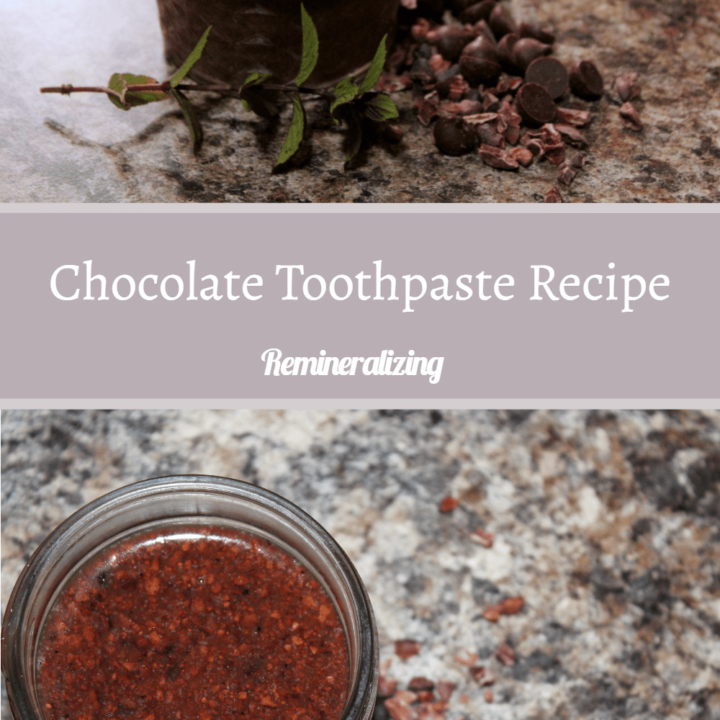
DIY All-Natural Chocolate Toothpaste
Learn how to make a fluoride-free chocolate toothpaste that re-mineralizes and whitens your teeth. Your smile will thank you later!
Ingredients
- 1/2 cup coconut oil
- 4 tablespoons baking soda
- 15 drops peppermint essential oils (optional)
- 1 tablespoon sea salt
- 1 teaspoon xylitol
- 2 tablespoons powdered cocoa nibs
- 1 tablespoon bentonite clay
- 2 4oz glass jars
Instructions
- Melt the coconut oil on medium-low heat until it is a liquid on a stove top.
- Crush the cocoa nibs with a mortar and pestle or grind with a coffee grinder until the nibs form a fine powder.
- Pour the melted coconut oil into a mixing bowl.
- Add the baking soda, salt, xylitol, cocoa nib powder, and bentonite clay.
- Add the essential oils of your choice and mix until everything is incorporated.
- Pour the mixture into two 4oz glass jars.
- Allow to cool completely before use.
Notes
To use: After flossing your teeth, dip your toothbrush head into the paste until you have the desired amount of chocolate toothpaste on the head. Wet the brush after dipping (if desired) and brush normally for 2 minutes.
Once you're done, spit out the toothpaste into a trashcan. Do NOT spit this toothpaste into any drains or you will clog them!
If your house is on the warmer end, you may want to store your toothpaste in the fridge to keep it in its solid form.
Common Questions for homemade toothpaste:
Q: How long does this toothpaste last?
A: This homemade toothpaste is best if used within 3 to 4 months, but I normally go through a jar in about two.
Q: Where is the best place to find cocoa nibs?
A: I recommend checking out a whole foods grocery store for these. If they’re not available locally, you can get the organic cocoa nibs I use on Amazon. (I only recommend products I would use myself. All opinions expressed here are my own. This is an affiliate link, and I may earn a small commission at no extra cost to you. Read my full privacy policy here.)
Q: Can I use different essential oils?
A: Absolutely! Feel free to change out the peppermint oil to any flavor that sounds appealing for you to have in your toothpaste. Or mix and match oils to make fun combinations, like orange chocolate mint or vanilla cherry chocolate. The options are endless!
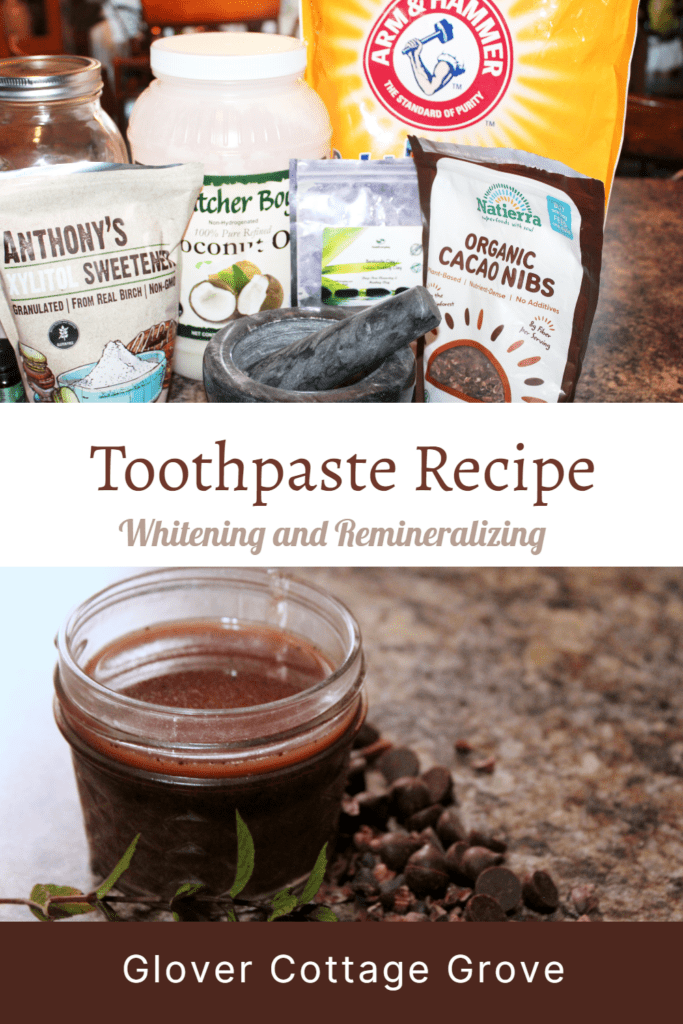

Leave a Reply
You must be logged in to post a comment.